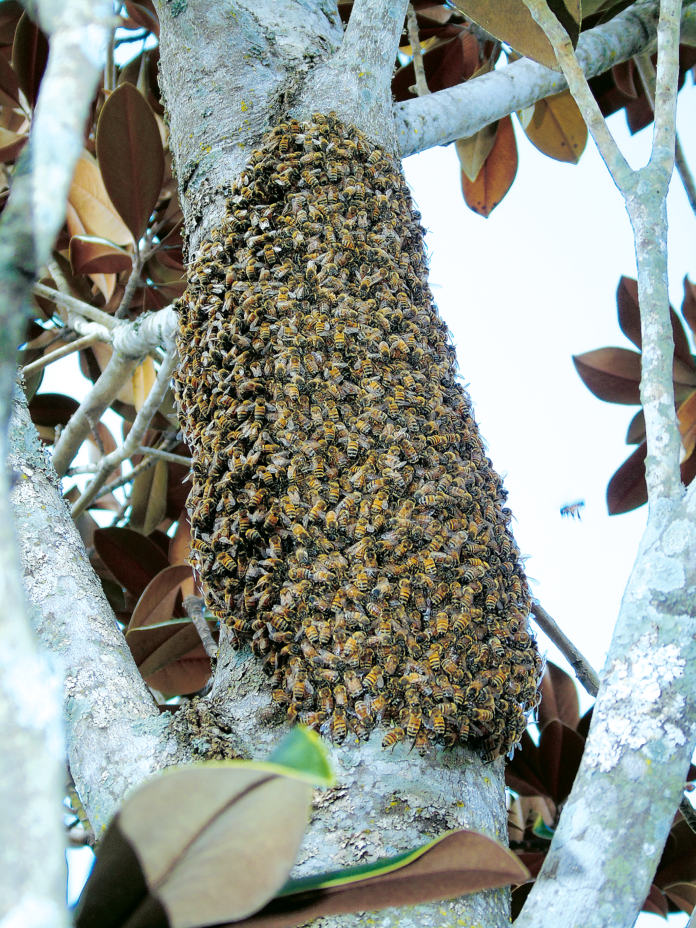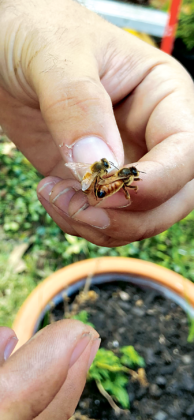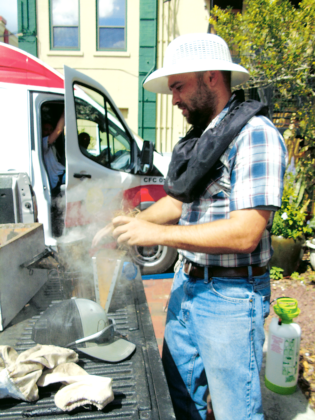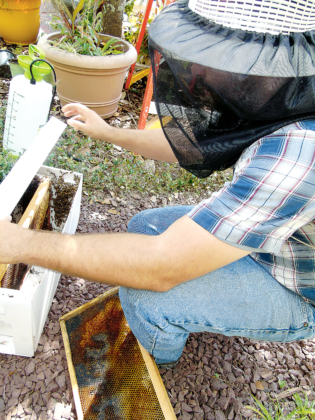
Garrett McWilliams was having a slow workday, so he was able to respond right away March 7 when asked if he could help move a swarm of honeybees gathered on a magnolia tree in Artisan Alley in Downtown DeLand.
McWilliams owns and operates Wild Honey Bee Farm in Umatilla, a business he inherited from his grandfather. Wild Honey Bee Farm manages, at any given time, between 250 and 500 colonies of 50,000 or so bees each.
McWilliams is also familiar with Artisan Alley and its garden, as he sells some of the farm’s products — beeswax candles, creamed honey and honey-based lotions — at the Friday night Artisan Alley Farmers Market.
Once on the scene of the bee swarm, McWilliams estimated the small colony on the magnolia tree at 2,000 to 3,000 bees. He said the bees had probably been part of a colony that had grown too large and thus made a new queen and divided.
Where they came from is unknown, McWilliams said, but the overcrowded hive was probably within 500 to 1,000 yards of Artisan Alley, he said.
Bees can fly as far as 5 miles, but likely wouldn’t have come that far.
“The farther they fly, the shorter their life,” McWilliams explained.
Donning his protective gear and climbing a ladder to reach the swarm, McWilliams first dusted the bees with smoke, which calms them, then gently spritzed them with water, to further reduce the chance of their flying away.
Then he used a soft brush to coax the bees into a special transport box designed by a beekeeper in Mims.
McWilliams was fortunate to find the swarm’s queen. Once he placed her in the box on the ground, many more bees flew to the box on their own.
Don’t take unnecessary risks, but a bee swarm is usually full of for-the-moment homeless, honey-laden bees that are fairly lethargic and easy to coax.
“That’s when the bees are at their most docile point,” McWilliams said. “There’s nothing to defend.”
To increase the chance that the fledgling colony will survive, McWilliams placed frames in the box to give the bees a head start on colony-building, without the need to create combs on their own. He also fed them some sugar-water.
Whether the bees of the Artisan Alley swarm will live and go to work for Wild Honey Bee Farm remains to be seen, McWilliams said.
It all depends on whether the queen can lay eggs.
“We still have to wait another week or two weeks, to see if she got mated properly,” McWilliams said.
It’s certain that the queen McWilliams found in the swarm was a virgin, he said, because she flew with her followers to Artisan Alley. Bees mate while flying, but once a queen mates, she cannot fly.
A “proper” mating, he said, requires 11 drones.
We wish them luck.
— Beacon reporter Al Everson contributed to this story
The buzz about bees
Thanks to beekeeper Garrett McWilliams for most of these fascinating facts about bees:
■ Bees must consume honey to fly. A forage bee setting out to collect nectar will load up on the exact amount of honey needed to fly to the flowers she already knows she’s going to. She knows this because scout bees flew flower-seeking missions earlier, and reported back about the location of and distance to, flowering plants.
■ Scout bees report their nectar-finding information with what’s called a “waggle dance.” A German-Austrian ethologist and Nobel Prize winner, Karl Ritter von Frisch, first decoded the waggle dance movements.
■ Most of the work in a bee colony is done by female bees. In a typical colony of 50,000 bees, there will be 100 to 200 drone bees. These are the only males, and their only purpose in life is to mate with the queen. Once that happens, the drones are killed so they don’t consume valuable hive resources. “It’s a pretty brutal society they have created,” beekeeper McWilliams said.
■ Whether a bee colony is super-aggressive may have more to do with leadership than with breed. McWilliams told of finding a long-abandoned bee box that belonged to his grandfather. It had been taken over by “Africanized” bees and was very aggressive. “They can be very dangerous,” he said. McWilliams explained that while a European bee colony will send out 10 bees to defend itself, an African bee colony will send out 1,000 defenders. “They will try to kill you,” McWilliams said. He and his workers replaced the African queen with a European queen, and the hive became calm and nonaggressive. With a nod to current world news, McWilliams said, Russian bees are also very aggressive.
■ A queen bee is created when the bees select one egg and feed it extra royal jelly, a nutritional substance secreted by nurse bees, and fed to all larvae in the colony. No one really knows how or why the one egg is chosen to become the queen, McWilliams said.
■ If a colony of bees becomes overcrowded, a new queen may be created, and a swarm like the one on Artisan Alley breaks away from the original colony. Bees also sometimes become disenchanted with their queen, and create another one to challenge the current queen for power.
■ Only a queen bee can sting without dying afterward. For all other bees, the act of stinging is a self-imposed death sentence.
■ We need bees. According to www.science.org.au, “Bees play a major role in the pollination of plants and crops, and are extremely important commercially for farming practices worldwide. It is an essential service— without pollination, life on the planet would be very different and probably much less diverse.” The website notes that about one-third of global food production is dependent on pollination, and that 80 percent to 90 percent of this is done by honeybees.





